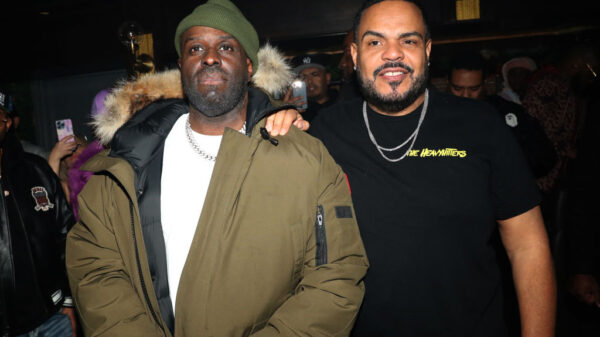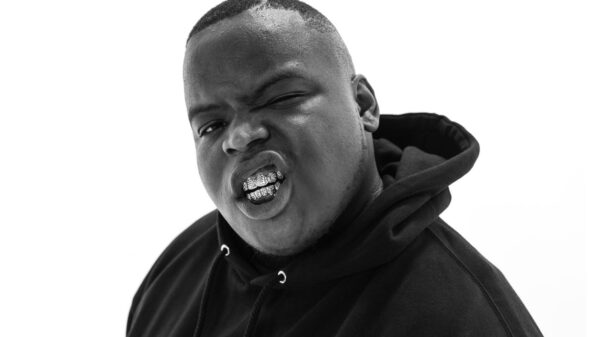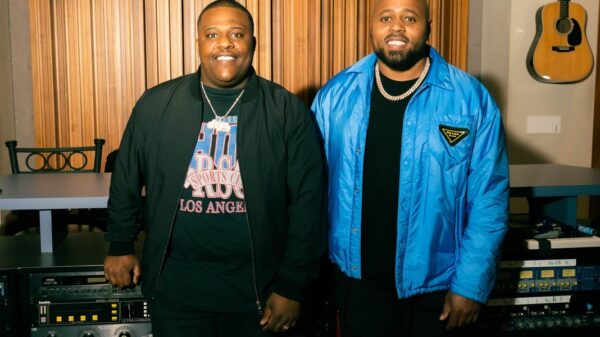In the early 1990s the four members of East Oakland’s “fantastic four” (Tajai, Phesto, Opio, and A-Plus), the Souls of Mischief, were flying high. Signed to Jive Records and working on their first studio album, they all shared a giddy excitement that something special was on the horizon. Yet, looming rap stardom didn’t stop this group of friends from being harassed by the police or needing different hiding spots across the city so they could smoke weed without fear of being thrown face-down into the back of a squad car.
Having grown up around the city’s 82nd Avenue — an area where locals drove around with powerful subwoofers that sent shock waves across the block, but also a place where carjackings, shootings, and police harassment were regular occurrences – A-Plus, an MC and also the group’s lead producer, said the Souls understood the importance of safe spaces. They therefore wanted Oaklanders to be able to press play and, for four minutes and forty-five seconds, be able to escape the pressures of a Californian city that registered a record-high 175 homicides in 1992.
“Our whole energy was: these punk ass cops, and this crime wave, aren’t going to stop our chill,” A-Plus said. “I guess the music represented another hiding spot [for us all].”
The immortal song he is referring to is of course “93 ’til Infinity,” a track A-Plus not only rapped on but also produced for the group. It cemented them as a sort of East Bay A Tribe Called Quest (a fellow Jive rap group), each member delivering tongue-twisting, shit-talking bars with the warmth and bite (“Crews talk shit, but in my face, they kiss my ass” taunted A-Plus in his own verse) of unruly teenagers rapping playground disses about their least favorite geography teacher. Their words, “This is how we chill from 93’ till,” took on an almost spiritual meaning for listeners, with this simple yet effective earworm hook serving as a musical inner sanctum whenever life got rough across the following 30 years.
“We never dreamed we would still be selling out shows 30 years later! It’s a trip. I’m still rapping alongside my friends and I’m nearly 50. We really worked our asses off for this.” – A-Plus
Yet “93 ’til Infinity” would also be nothing without its dusty yet soul-cleansing, jazz-enthused beat, which swirled with a wistfulness that was completely out-of-step with the more brash Oakland hood rap of peers like Too $hort and Richie Rich. It isn’t that A-Plus disagrees with this sentiment; he is, after all, the song’s producer. However, in conversation, the 48-year-old is naturally humble and tends to divert attention over to others. Spontaneously rapping his comrade Phesto’s resolute-under-pressure bars (“N****s is testing my patience, but I stay fresh”) for example, is a trademark deflective move for the Souls member known as the “the architect,” a.k.a the one who likes to pull the strings from afar.
It can, therefore, be difficult to get him to celebrate himself as an individual, rather than talk up the collective. “I’ve always pushed my involvement to the back,” A-Plus admitted over a hissing phone line. “I didn’t want to get extra attention from anyone else just because I made some of the beats. I’m not a sneaky motherfucker: I always air on the side of positivity and try to help others. As a beatmaker, all I wanted were the people I was a big fan of – like DJ Premier and Lord Finesse – to know that I was dope. That’s all that mattered, and it’s a crazy dream I achieved.”
Members of Souls of Mischief pose during Coachella 2001 at the Empire Polo Fields on April 28, 2001 in Indio, California. (Photo by Tim Mosenfelder/Getty Images)
Start small, but stand your ground
To truly understand how A-Plus achieved this crazy dream, and how “93 ’til Infinity” became the kind of influential rap song every paradigm-shifting artist — from Kanye West to Eminem to Andre 3000 — has cited as a formative influence, you must start with the producer and MC’s childhood. His parents were immigrants from Jamaica, arriving in America just before A-Plus was born, where they fostered a loving, deeply musical household.
“From ska to R&B, reggae, rock, and rap, they didn’t discriminate at all when it came to genre,” A-Plus said. “This is why they ended up playing ‘Rapper’s Delight’ by The Sugarhill Gang, which I heard when I was eight. It just painted vivid pictures in my brain. When they played me ‘The Message’ by Grandmaster Flash and the Furious Five, I was hooked. It became my dream to be in a successful rap group.”
His school friend Tajai (real name Tajai Massey) had similar hopes and the pair bounced rhymes off one another as early as eight years old. Their very first was a Run-DMC-esque song called “Perpetrators,” which included the bars: “Perpetrators are the ones we hate / they come around from state-to-state and bite my rhymes / they will bite yours too.” Cringing at the memory, A-Plus said: “It was rudimentary rhyming from elementary school kids, but we attracted some attention as this kind of novelty teenage group. We worked with Sir Jinx and even auditioned for Eazy-E, who liked us. Obviously, we weren’t quite Souls of Mischief yet.”
As the pair got older, they added more members, with high school friends Phesto and Opio cementing a dynamic that married mischief-making with socially conscious souls. As the Souls of Mischief came to fruition, they also had the solid foundations of the wider Hieroglyphics crew to lean back on, which included the likes of Del the Funky Homosapien, Pep Love, Domino, DJ Touré, and Casual. “The Hieroglyphics were all united by the idea of telling stories that pushed our people down a safe path,” A-Plus said. I asked A-Plus to elaborate on what was making them all feel so unsafe in the first place. “Crack. That epidemic is when the crimes started escalating. Before crack, I don’t remember it being dangerous in Oakland at all. It was a community where people looked after one another. But when crack hit the streets, the city changed and the violence went up.”
He paused, before clarifying: “But although the Souls were trying to make positive rap, it was important we did it without being corny. We were still going to talk our shit and stand our ground.”
The makings of a beat and a record deal
These ideals attracted the attention of Jive Records and the Souls quickly got to work on their debut studio album, which would eventually be titled 93 ’til Infinity, due to the success of the project’s infectious lead single. Whether it was Tajai pondering why there were no cocaine fields in American ghettos on “Tell Me Who Profits”, or A-Plus explaining the cause-and-effect actions that meant even peaceful people were forced to bear arms in his street, the music they recorded was consistently probing. It also carried a wicked sense of humor, with the smoked-out, Freddie Hubbard-sampled horns of “Never No More” inspiring Opio to rap like an inner city Dennis the Menace: “Opio disposes of crews like snotty tissues.”
Yet the project lacked an obvious single and something to glue everything together. Thankfully this changed when A-Plus suddenly remembered a beat he had previously given to Pep Love. The beat in question had been sparked by A-Plus learning that DJ Premier had sampled the title track from Billy Cobham’s 1974 Crosswinds album on Gangstarr’s “Here Today, Gone Tomorrow.” It inspired the producer to track down the vinyl himself, hunting through all the bargain bins in Oakland. When he did finally locate a copy, he was instantly wowed by the penultimate track, “Heather.” It carries a progressive, Pink Floyd-esque synth line that glistens with sadness and a saxophone section that hums languidly like the cries of a wounded giant. “At that time in hip-hop people weren’t sampling stuff like ‘Heather,'” A-Plus said.
“They were sampling harder and funkier-type samples. Way too much James Brown. Somber samples just weren’t the flavor in 92/93, so I was trying to be experimental. Back then I was sampling on 45s and there was a Macgyver-type producer trick I learned. When you used the E-mu SP-1200 you got more sample time if you used 45s. It meant I could stretch out [the pain of the] sample and make the horns sound even more chilled out.”
Combining this sample with the fidgety tribal drums and energy from a raucous church service, where all the sacramental wine had been spiked with acid, of “The Jam” by Grand Central Station was a magic combination; a cross-section of joy and melancholy. A-Plus said he also avoided the reel filter bass lines producers in the early ‘90s were using — so the keys were more prominent, creating a beat you could both nod your head to and also appreciate its finer musical layers. “The beat just flowed out of me. It took about 30 minutes, max. The sound of it just helps you relax.”
But when the other Souls found out A-Plus had given such a special beat to Pep Love, they weren’t entirely happy, which started a new rule in the crew that the producer must offer all his beats to the Souls of Mischief before anyone else. Luckily, they got the beat back as Pep had not yet laid down any verses. When it came to the Souls laying down their own verses, A-Plus remembered a previously unrecorded song they had written called “91 til Infinity,” which was slow and teary-eyed. “It was a song about friendship,” he said.
“Actually, I remember I shed a tear when I did my raps to the fellas. Anyway, the decision was made to take ”91 ’til Infinity’ and give it more party vibes by putting it with this new beat. Remember, we were recording our first fucking album, dude. We were in a happy place, chilling. We totally revamped the concept. ’91 ’til Infinity’ became ’93 and everything became more celebratory.”
Souls Of Mischief – 93 ‘Til Infinitywww.youtube.com
Pen to wax and the rest is history
Recording occurred in the cramped Studio D at San Francisco’s famed Hyde Street Studios, with A-Plus coming up with a song structure where every member wrote three verses – one eight bars, one six bars, one four bars. Inside there was a party-like atmosphere. “We were just some kids saying some ill shit. It was like, we’re teenagers who are living out our dreams, and we want this to carry on for infinity. Fuck all y’all who doubted us. Fuck the punk police officers; we chillin’. We on some fly shit and y’all ain’t fucking with us. When the song was finished, I played it back and the consensus was: wow, we really got something special here.”
A minor hit, “93 Till’ Infinity” nonetheless put the Souls of Mischief on the map, boosted by a music video (directed by Michael Lucero) that saw them abandon the conventions of the flossy rap music video to instead run amok around nature in Yosemite National Park. However, A-Plus claimed Jive still fudged the album release, meaning the record didn’t scale the heights it was expected to. By album number two, 1995’s No Man’s Land, the Souls were part of a label that fundamentally misunderstood their own act, which was reflected in its harsher sound. All the dizzying flows and heartfelt camaraderie were replaced with a more aggressive, cutting, anti-mainstream feel. This was crystallized by the sadistic atmosphere of “Where The Fuck You At” and “Secret Service,” a concept song about assassinating political leaders with knives to the kidneys that carried a nihilistic boast from A-Plus about polishing his gun four times a day. The music was great, but also noticeably very different from its predecessor.
Of that period, A-Plus doesn’t have the fondest of memories. “In the mid-’90s, there was this gangsta rap gold rush and something happened in the music industry where peaceful rap music was being taken off the table. The labels didn’t want rappers who sold the concept of chilling anymore. They couldn’t turn us into gangstas, so Jive said you have to become a pop group like [DJ] Jazzy Jeff & the Fresh Prince if you want to continue making music with us,” A-Plus said. “Our response was fuck that, we’re taking you to No Man’s Land. Like fuck you, we’re going to give you this dark ass album instead. We left pretty soon after it dropped.”
This, however, turned out to be a blessing in disguise for the group. Free from the interference of boardroom executives, the Souls embraced independence with real intelligence and verve, becoming one of the first-ever rap groups to utilize the internet to stay in touch with fans, selling hundreds of thousands of records at pop-ups promoted on the World Wide Web. Today, these are marketing plans that are every-day, but back then the Souls were breaking new ground.
Independence also freed up the four Souls’ members to record 3rd Eye Vision, the striking debut album for the Hieroglyphics crew. This 1998 record became a jewel in the crown of US underground rap, boosted by its smooth, Patrice Rushen-sampling lead single, “You Never Knew.” On it, A-Plus (who also produced the song) arguably rapped the crew’s mission statement: “It’s not a wrong thing / To be addicted to the microphone like a heroin fiend.”
“We really worked our asses off for this”
In the years that followed, the Souls continued to release albums independently (the cream of the crop arguably being 2009’s underrated Montezuma’s Revenge), with A-Plus choosing to stay in-house and produce the lion’s share of the music. The idea of working with the “evil liars” he’d encountered at major labels was no longer a viable option, even if it meant missing out on big-name collaborations. He even released his own solo album, 2007’s My Last Good Deed, an album conceptualized while looking out at the water in Jamaica during a trip to commemorate A-Plus’ own grandmother passing away. The weeded-out title track has a line about how whenever you encounter a fork in the road, you should pick it up and keep on moving; an ethos that mirrored A-Plus’ own hard-won career journey.
All these years later and A-Plus is still eating off rap. The boast on “You Never Knew” about “stacking cash till I can get moms’ a mansion” has also been realized; well, sort of. “I do real estate with my moms now. We do it together as a team. That is my version of getting her a mansion. God Bless her.” He’s currently in the middle of a world tour celebrating the 30-year anniversary of the 93 ‘til Infinity album. One thing that has been surprising is the age of the people in the crowds. “There’s an oversaturation in hip-hop right now, so there’s a whole section of kids maybe looking to the past for alternatives,” he theorized.
“You look out to the crowd and there’s 18-year-old skaters rapping the lyrics to ‘93 Till Infinity,’ word-for-word. It’s beautiful. We never dreamed we would still be selling out shows 30 years later! It’s a trip. I’m still rapping alongside my friends and I’m nearly 50. We really worked our asses off for this.”
Perhaps the clearer truth is that because young people of the 2020s have inherited the pitfalls of irreversible climate change and a news cycle that swings violently from one crisis to another, a song about chilling with blunts in “Owen’s Basement” and basically hiding from the world is a welcome tonic. In fact, as a song, “93 til Infinity” has become a rite of passage in hip-hop, with artists from Freddie Gibbs to J. Cole freestyling over its instrumental at pivotal moments in their careers. Its sound is also omnipresent, with A-Plus’ mellow yet caustic beat making him a forefather of the lo-fi hip hop sound that still dominates the current underground rap landscape.
One of the things A-Plus is most proud of is the final word you hear just before the song “93 ‘Till Infinity” shuts off: Peace. It is one of the things he would like the song’s success to be measured by. “I think that’s the best thing hip hop ever did – making ‘peace’ a word people use so frequently as both a greeting and an exit,” he concluded. “My Father, rest in peace, told me that’s what he loved most about rap. Its use came from the Five-Percent Nation and we heard it from Rakim too. I guess living in the stressful environment we lived in, using rap as a peaceful outlet was important. It’s important that it is the last word you hear on ’93 ’til Infinity.’”
__
Thomas Hobbs is a freelance culture and music journalist from the UK. His work has appeared in the Guardian, VICE, Financial Times, Dazed, Pitchfork, New Statesman, Little White Lies, The i and Time Out.
Read the full article here

































